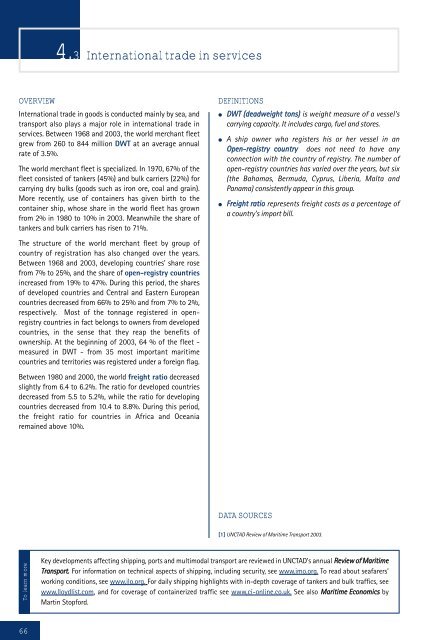Development and Globalization: - Unctad
Development and Globalization: - Unctad
Development and Globalization: - Unctad
You also want an ePaper? Increase the reach of your titles
YUMPU automatically turns print PDFs into web optimized ePapers that Google loves.
OVERVIEW DEFINITIONS<br />
International trade in goods is conducted mainly by sea, <strong>and</strong><br />
transport also plays a major role in international trade in<br />
services. Between 1968 <strong>and</strong> 2003, the world merchant fleet<br />
grew from 260 to 844 million DWT at an average annual<br />
rate of 3.5%.<br />
The world merchant fleet is specialized. In 1970, 67% of the<br />
fleet consisted of tankers (45%) <strong>and</strong> bulk carriers (22%) for<br />
carrying dry bulks (goods such as iron ore, coal <strong>and</strong> grain).<br />
More recently, use of containers has given birth to the<br />
container ship, whose share in the world fleet has grown<br />
from 2% in 1980 to 10% in 2003. Meanwhile the share of<br />
tankers <strong>and</strong> bulk carriers has risen to 71%.<br />
The structure of the world merchant fleet by group of<br />
country of registration has also changed over the years.<br />
Between 1968 <strong>and</strong> 2003, developing countries' share rose<br />
from 7% to 25%, <strong>and</strong> the share of open-registry countries<br />
increased from 19% to 47%. During this period, the shares<br />
of developed countries <strong>and</strong> Central <strong>and</strong> Eastern European<br />
countries decreased from 66% to 25% <strong>and</strong> from 7% to 2%,<br />
respectively. Most of the tonnage registered in openregistry<br />
countries in fact belongs to owners from developed<br />
countries, in the sense that they reap the benefits of<br />
ownership. At the beginning of 2003, 64 % of the fleet -<br />
measured in DWT - from 35 most important maritime<br />
countries <strong>and</strong> territories was registered under a foreign flag.<br />
Between 1980 <strong>and</strong> 2000, the world freight ratio decreased<br />
slightly from 6.4 to 6.2%. The ratio for developed countries<br />
decreased from 5.5 to 5.2%, while the ratio for developing<br />
countries decreased from 10.4 to 8.8%. During this period,<br />
the freight ratio for countries in Africa <strong>and</strong> Oceania<br />
remained above 10%.<br />
To learn more<br />
66<br />
4.3 International trade in services<br />
● DWT (deadweight tons) is weight measure of a vessel's<br />
carrying capacity. It includes cargo, fuel <strong>and</strong> stores.<br />
● A ship owner who registers his or her vessel in an<br />
Open-registry country does not need to have any<br />
connection with the country of registry. The number of<br />
open-registry countries has varied over the years, but six<br />
(the Bahamas, Bermuda, Cyprus, Liberia, Malta <strong>and</strong><br />
Panama) consistently appear in this group.<br />
● Freight ratio represents freight costs as a percentage of<br />
a country's import bill.<br />
DATA SOURCES<br />
[1] UNCTAD Review of Maritime Transport 2003.Discussion Paper No. 159.<br />
Key developments affecting shipping, ports <strong>and</strong> multimodal transport are reviewed in UNCTAD's annual Review of Maritime<br />
Transport. For information on technical aspects of shipping, including security, see www.imo.org. To read about seafarers'<br />
working conditions, see www.ilo.org. For daily shipping highlights with in-depth coverage of tankers <strong>and</strong> bulk traffics, see<br />
www.lloydlist.com, <strong>and</strong> for coverage of containerized traffic see www.ci-online.co.uk. See also Maritime Economics by<br />
Martin Stopford.

















